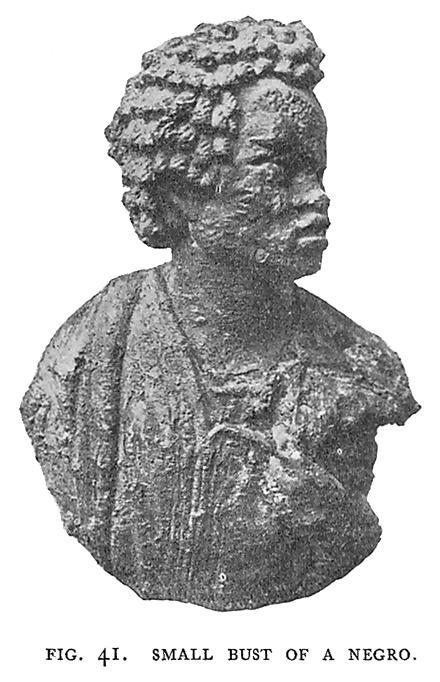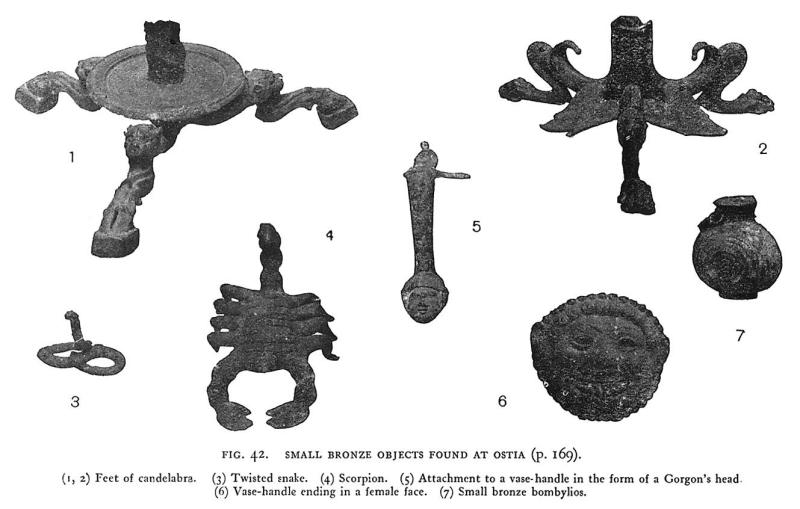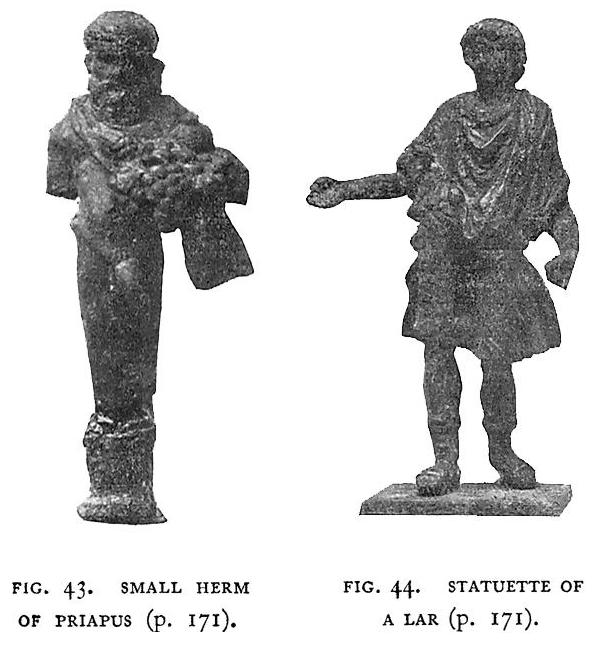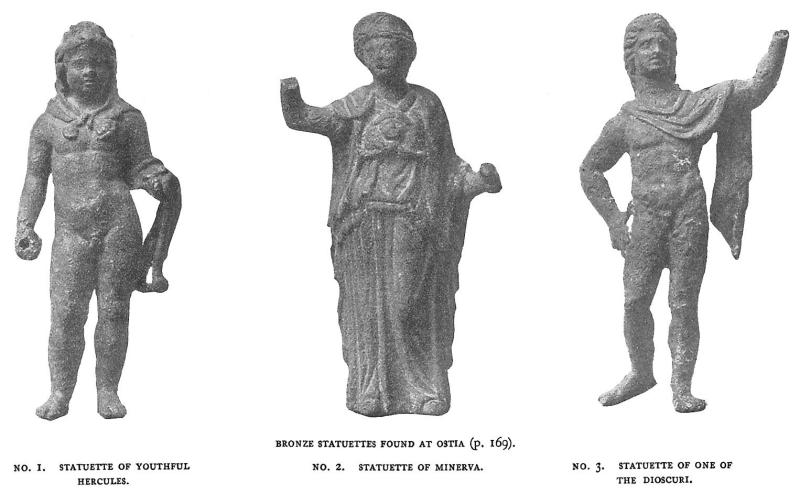EXPRESSIONS OF ART IN A ROMAN COMMERCIAL CITY: OSTIA
By GUIDO CALZA
Ispettore degli scavi di Ostia antica
Journal of Roman Studies 5 (1915), 165-172 (1)
The noteworthy discovery which I have the honour of illustrating for the Journal of Roman Studies is a very recent one, and it was unlooked for because one would not expect to find a rich and beautiful series of small artistic bronzes among the ruins of a great bakehouse. This building consisted of a double series of rooms in which are gathered together the machines for crushing the grain, the machines for kneading the flour (machinae quae farinae subiguntur), and, lastly, two enormous ovens for the making of the bread. This great bakehouse, placed in the heart of the city, near the temple of Vulcan,(2) was destroyed by a fire in the third century, as is proved by certain coins, and it was never re-built. The small bronzes, touched but not destroyed by the fire, were found among the ashes covering the pavement of the ground floor, and since they have nothing in common with the great bakehouse, they come assuredly from the first floor of the building, which was perhaps the dwelling-house of the miller, and it may be supposed from this that they were the religious and artistic furniture of his private chapel.(3)
The population of Ostia in Roman times seems to have been devoted to the traffic and the commerce of Rome, and the discovery of a group of bronzes, all of remarkable interest both for their style and for their subject, among the ruins of a miller's dwelling may well cause us some surprise.
The Roman people, composed of merchants, soldiers and jurists, who, to impose their sway upon the world, employed their commerce to invade it, their arms to conquer it, and their laws to make that conquest permanent, this people, in whom Virgil himself recognised
(1) I am indebted to Dr. Ashby who has very kindly translated this article from the Italian.
(2) T. Ashby, 'Recent Discoveries at Ostia,' J.R.S. ii, 184.
(3) cf. the house-shrine with bronze statuettes of the lares, Mercury and the Capitoline triad found at Pompeii in the Casa degli Amorini dorati, Not. Scav. 1907, p. 564 ff. figs. 14-17.
166
no artistic qualities,(1) has left evidences of an artistic production of which we cannot boast to-day. Surprising as it may be, this diffusion of art does not stop at the monuments of Rome nor at the villas of the wealthy, as Ostia bears witness, but it crosses the thresholds of the tenement-houses of shopkeepers and officials, and is to be found even on shop-counters. Though our mode of life and our customs have not changed so greatly, and though we are capable of appreciating art and artists, yet we do not find among ourselves the same phenomenon we recognise in antiquity. We have given dignity to the conception of art and of the artist, but both have become somewhat remote from our daily life, and to-day art is certainly more extraneous and less essential to life than it was in antiquity. In the Roman world the artist was nothing but an artisan; sculptor and stone-cutter were synonymous terms. Inasmuch as art was a trade, every trade became an art, and thus art entered everywhere, modestly, it is true, but with confidence and tenacity. It was, we may say, only a pure expression of form, but it penetrated everywhere, were it only to impress its stamp on the buckle of a garment, or on a kitchen pot.
We can hardly offer any modern parallel to the example which Ostia offers us (although it is only one of many) of a group of artistic bronzes in a middle-class house of the commercial suburb of Rome. In this group we find not only Minerva and Mercury, Hercules and the lar, the expression of the 'pietas' of the owner, but lamps and vases, feet of furniture and facings of beds, vessels of everyday use, candelabra and little bibelots, even the bust of a young negro slave. These objects can only have been meant for the adornment of the house and its daily life. The warning which in Virgil follows on the line already quoted
Tu regere imperio populos, Romane, memento:
Hae tibi erunt artes: pacisque imponere morem,
Parcere subjectis, et debellare superbos
had long ago been blazoned on the banners which spread the empire of Rome over the world, and art was no more, as Virgil feared, a deviation from the imperialist aims of Rome. It was by now necessary, and was appreciated even by the untaught shopkeeper. This unknown citizen of Ostia, the owner of this fine artistic treasure, tells us in humble way that, if in matters of art the Romans had been at first the Americans of antiquity, more often eager collectors than good connoisseurs, nevertheless they had not been slow to acquire a personality in art.
In the varied group of these small bronzes, the place of honour
(1) Excudent alii spirantia mollius aera: Aen. vi, 847.
167
belongs perhaps to the small bust of a negro (fig. 41). He has short curly hair, an upturned nose, thick lips, and a pronounced frontal projection above the right eve. Though he reproduces realistically enough the characteristics of his race, both attitude and expression are on the whole refined. He wears over his tunic a sleeved cloak like a 'paenula' to which is attached a hood ('cucullus') carried

forward on to the shoulder and held by the left hand. In this pose we may remark the novelty of this labourer's garb which seems strange for a young Ethiopian slave,(1) as well as the manner of wearing the hood usually hung over the back.(2) This method, absolutely new to us, apart from the actual fact by which it is inspired, certainly gives a pretty, almost coquettish, artistic motive.
(1) The representation of nudity seems more usual, and is in fact up till now the only one met with in the figures of negroes: compare the fine Vienna bronze (R. von Schneider, Jahrb. d. Kunsthist. Sammlungen des allerhöchsten Kaiserhauses, iii, p. 3 = Reinach, Répertoire, ii, p. 562, 2, and the famous bronze from Châlons-sur-Sâone in the Bibliothèque Nationale: Rayet, Monuments, pl. 58 = Reinach, Répertoire, ii, p. 561, 4). Only in one of the small clay seal-impressions from Selinunte is the head covered by a flat cap (Not. Scav. 1883, tav. xi, nos. 164 and 165).
(2) See S. Reinach in Saglio-Pottier, s.v. Cucullus.
168

169
Nor are the merits of this bronze confined to its style, for although representations of negroes are not very rare in Greek art,(l) they are for the most part confined to heads on coins and on small objects (2): in the Roman world they are somewhat seldom met with, and are even more exclusively used for the purpose of decoration on pottery (vases, lamps, cups) and also on bronze objects (lamps, weights, vases, etc.).(3) This bronze from Ostia, therefore, may be regarded as one of the rare representations of a negro, so far as is known, which belongs to the class of genre figures of which the Romans, following Alexandrine precedents, were so fond. The Romans, in fact, wished to be the real successors of the Greeks, of those "mikrophilótimoi" of Theophrastus,(4) who liked always to surround themselves with strange objects, and were fond of having negro slaves.(5) In Roman sepulchral art, in fact, we often see negroes as bath-servants, dancers, mountebanks, and the like. With this negro may be grouped other objects of a non-religious character: two candelabra, with griffins' claws and lions' heads (fig. 42, nos. 1, 2); a twisted snake (no. 3), lively and realistic; a scorpion, a somewhat rare representation except in relation to the cult of Mithras (no. 4); a Gorgon mask, the attachment of a vase-handle (no. 5); a vase-handle ending in a female mask (no. 6); and other vases among which the most graceful is a small 'bombylios' (no. 7).
The other bronzes of the group lead us on to religion. The small figure of the boy Hercules is of the type of the statue of the Capitol (6) (plate xi, no. 1), but is considerably more pleasing, inasmuch as manly strength is here shown in a body still boyish in its proportions and facial expression. The robustness of the form does not remove the characteristics of childhood clearly seen in the plump face. This Hercules, with his ingenuous expression, is still a child, despite the thick nose, the swollen neck and the full chest. The lion-skin, which is knotted together on the chest, falls behind almost to the loins, with the softness of a thick fur, and falls over the left arm, which is stretched forward to hold the apples. Thus the simplicity of the child is expressed also in the pose of the body.
The statuette of Minerva (plate xi, no. 2) presents points of
(1) Euripides seems to have brought negroes on to the stage in the satyric drama Busiris. In the Galleria dei Candelabri in the Vatican, there is the marble statue of a negro slave carrying a 'lekythos' (Clarac, 883, 2250 = 541, 2, Reinach; Helbig, Führer, 375, and references).
(2) Besides the clay seal-impressions of Selinunte already cited with the representations on coins, heads of negroes are also found on 1ead tesserae (Bull. Corr. Hell. viii, 1884. pl. iv, 99, 100. A vase with a negro's head is published in Not. Scav. 1878, plate v.
(3) A negro was recognised by Hirzel in a mosaic of Tusculum (Mon. Inst. vi-vii, 1863, plate 82; Annali, 1863, p. 393 ff.), an Ethiopian dancer, found at Herculaneum, is now in the Naples Museum (Bronzi d'Ercolano, ii, tav. xc = Reinach, Répertoire, ii, p. 563, 4), a negro charioteer in a Pompeian relief is in the same Museum (Mus. Borbonico, vi, tav. xxiii = Reinach, Rép. de Reliefs, iii, p. 94, 1, and Guida Ruesch, no. 570. I omit the figurines in which the characteristics of the negro race give place to the abnormal peculiarities of individuals.
(4) Charact. 21.
(5) Mon. Ann. e Bull. Inst. 1856, tav. 9; cf. Juv. vi, 599; Mart. vi, 39, 8.
(6) Salone 3 (British School at Rome, Catalogue of the Museo Capitolino, i, p. 275) ; cf. Palazzo dei Conservatori, Sala degli orti Lamiani, no. 35.
170
greater novelty and interest. The aegis on the breast and the position of the arms, the right resting on the spear, the left grasping the shield, denote this goddess, but the pose of the figure belongs rather to Iuno than to Minerva: she is clothed in a chiton folded in a deep 'apoptygma.' On the right shoulder is a cloak, fastened one hardly knows how: at the back it falls almost to the feet, while in front it is brought over the left arm. On the forehead, can what seems a diadem from which the front hair escapes be transformed into a helmet after the pattern of a Phrygian cap? For Minerva wears

the helmet, not the diadem. A helmet of this kind, which would lack only the point (and in fact something is wanting at the top of this diadem), may certainly be imagined.
We should thus have a singular case of the mingling of two different artistic motives; the union in a single figure of two poses which belong to two great Olympian divinities. This syncretism, if it may be so called, of Hera and Athena is certainly due to Roman art. And I imagine that it may have some connexion with the traditional form in sculpture of Iuno Sospita of Lanuvium and with the creation of the figure of the Dea Roma. Iuno Sospita, as we know
171
her in statuary and on coins of the time of Antoninus Pius,(1) and from the description of Cicero,(2) may be said to combine motives proper to Athena and to Hera. While the Iuno Sospita of the Vatican (3) has a goatskin on her head, the Iuno of the Museo Capitolino (4) and that of the Vescovali collection (5) have a 'stephane' like that of the small Minerva from Ostia. With the latter the Iuno of the Vescovali collection also has in common the cloak which falls behind the back. So, too, in the personifications of the Dea Roma, Roman art did not find inspiration only in the types of Athena, but the statuary pose is due to the figure of Iuno. If then we remember this fusion of elements in two creations of Roman art, and observe the whole pose of this small Minerva from Ostia, which undoubtedly recalls motives proper to Iuno, we may trace a certain syncretism in this figurine as well, and regard it as a genuine product of Roman art in Latium, which reveals, for the third century A.D. to which it belongs, an entirely new statuary type, which may not have originated much earlier than the age of the Antonines.
The greater divinities may serve as an introduction to the less. The small semi-nude herm of Priapus (fig. 43) is very graceful: part of the chest and the back are covered by a nebris which is folded round the left arm, and by this means carried up to the chest; it contains various fruits, among which we may distinguish apples and grapes. The little god looks at them, bending his head on to his breast, which is swept by his rough beard. If the signs of Priapus were not clear, the expression of the face, refined and good-humoured as it is, would make one believe him a Silenus. For a work of such small dimensions, the perfection of every stroke and the accuracy of every detail are remarkable. One of the Dioscuri (plate xi, no. 3) closely resembles (though with the pose of the arms reversed) a small bronze of the Gréau collection.(6)
The owner of this Olympus on a small scale could not be without the tutelary genius of the house; and the small lar which also belongs to the collection is an exquisite reproduction of the type proper to this divinity (fig. 44). He stands upon a square box decorated with a laurel branch, the leaves and berries of which are in silver. He wears a short-sleeved tunic which ends above the knee and is drawn in at the waist by a belt, from which falls the 'sinus' of a cloak passed like a scarf over the left shoulder. The right hand is stretched forward and open, and holds a patera; the lowered left hand perhaps held the cornucopiae. The legs are bare, the left being slightly bent back, and the feet are shod with sandals. Though the type presents no novelty, we must note in this lar, as in the
(1) Roscher, Lexikon, s.v. Iuno, pp. 606 ff.
(2) de Nat. Deorum, i, 29, 83.
(3) Clarac, 418, 732 (p. 200, 7 Reinach).
(4) Scala 6, British School Cat. vol. i. p. 84.
(5) Clarac, 419, 733 (p. 201, 1 Reinach).
(6) Reinach, Rép. ii, p. 109, 6; Coll. Gréau, pl. xl. 1027.
172
other bronzes at Ostia, a faultless dignity in the type and an excellent execution.
Ostia, then, continues to be a mine, apparently inexhaustible, of objects of art. This Roman town at the mouth of the Tiber, or rather this suburb of Rome, now vindicates its importance not only for the rapidity with which it is being excavated, but for the abundance and interest of its monuments, and the great quantity of artistic objects which it reveals to us. Thus Italy still, and indeed more than ever to-day, seeks in her own soil the traces of ancient Rome.
